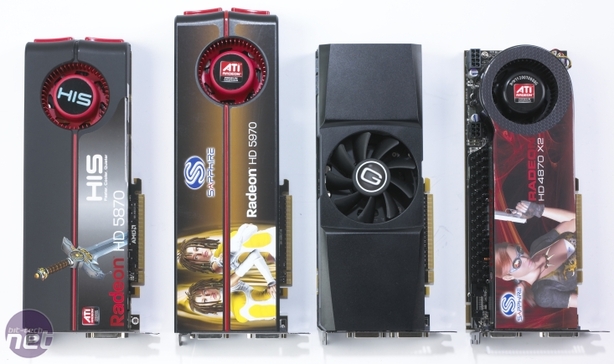Why no Folding Scores?
As one of the genuinely useful distributed computing applications, we've had an interest in Folding@Home for a while. For the past year or so we've tested graphics cards for their folding ability, as GPUs are great for folding. However, the entire Radeon HD 5000-series isn't compatible with the latest GPU folding client.There is a rumour that Stanford will release a new client soon that will, but until then (and until we see how this new client performs), you shouldn't buy Radeon HD 5000-series card if you care about folding.
Performance Analysis
Only in S.T.A.L.K.E.R. Clear Sky did we see the card's potential fulfilled. In this game, the Radeon HD 5970 was simply phenomenal and completely obliterated the three cards that previously squabbled over who owned the rights to the World's Fastest Graphics Card title. If we only took this game, the HD 5970 would definitely be the new World's Fastest Graphics Card, but it's not just about one game - it's about how a card performs in a variety of games, which is what we've done today.Fallout 3 ran well on the HD 5970, but you really need resolutions higher than 2,560 x 1,600 to take advantage of the horsepower this card has. Even at 2,560 x 1,600 with 4x AA, the Radeon HD 5970 was CPU-limited - enabling anti-aliasing caused the minimum frame rate to drop from 51 fps to 48 fps, with the average remaining consistent at 85 fps. The Radeon HD 5870, GeForce GTX 295 and Radeon 4870 X2 weren't far behind the new HD 5970 even at 2,560 x 1,600 when it came to average frame rates, but the minimum of even the GTX 295 was 9fps of the pace of the HD 5970. All the cards delivered a perfectly smooth game experience at the native resolution of our 30in screen.
A recent update to Dawn of War 2 has caused minimum frame rates to take a huge hit and, as a result, the HD 5970 can only manage an acceptable minimum frame rate at 1,920 x 1,200 with 4x AA and 16xAF. Thankfully for ATI, the other cards on test couldn't muster high enough minimums to compete at these settings. However, as soon as you disable anti-aliasing, the GTX 295 and HD 5870 managed playable frame rates. The HD 4870 X2, on the other hand, suffered from choppy minimums through all of our tests in this title.
The HD 5970 scaled pretty well in Crysis, delivering between a 50 and 60 per cent improvement in minimum frame rate over the HD 5870. The HD 5970 is also the first graphics card to deliver playable frame rates in Crysis at 2,560 x 1,600 with 0x AA 16x AF at High quality; 4x AA is still a stretch too far. Of course, Crysis is a fairly Nvidia-biased game, so it's no surprise that the performance difference between the HD 5970 and GTX 295 isn't all that great - it's generally horses for courses until you get up to 2,560 x 1,600, where the HD 5970 returned an impressive frame rate when we didn't use AA (and comparatively weak performance when we did).
Finally, Call of Duty: World at War has been one of AMD's bugbears since the day it was released - its dual-GPU cards suffer from stuttering frame rates and that hasn't changed with the HD 5970. Even if we discount the minimum frame rates though, the HD 5970 was quite often slower than Nvidia's GTX 295 in this game. Given the popularity of the Call of Duty franchise, we'd argue that this is one game which AMD needs to perform well in.

MSI MPG Velox 100R Chassis Review
October 14 2021 | 15:04










Want to comment? Please log in.